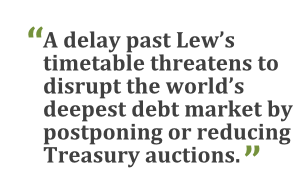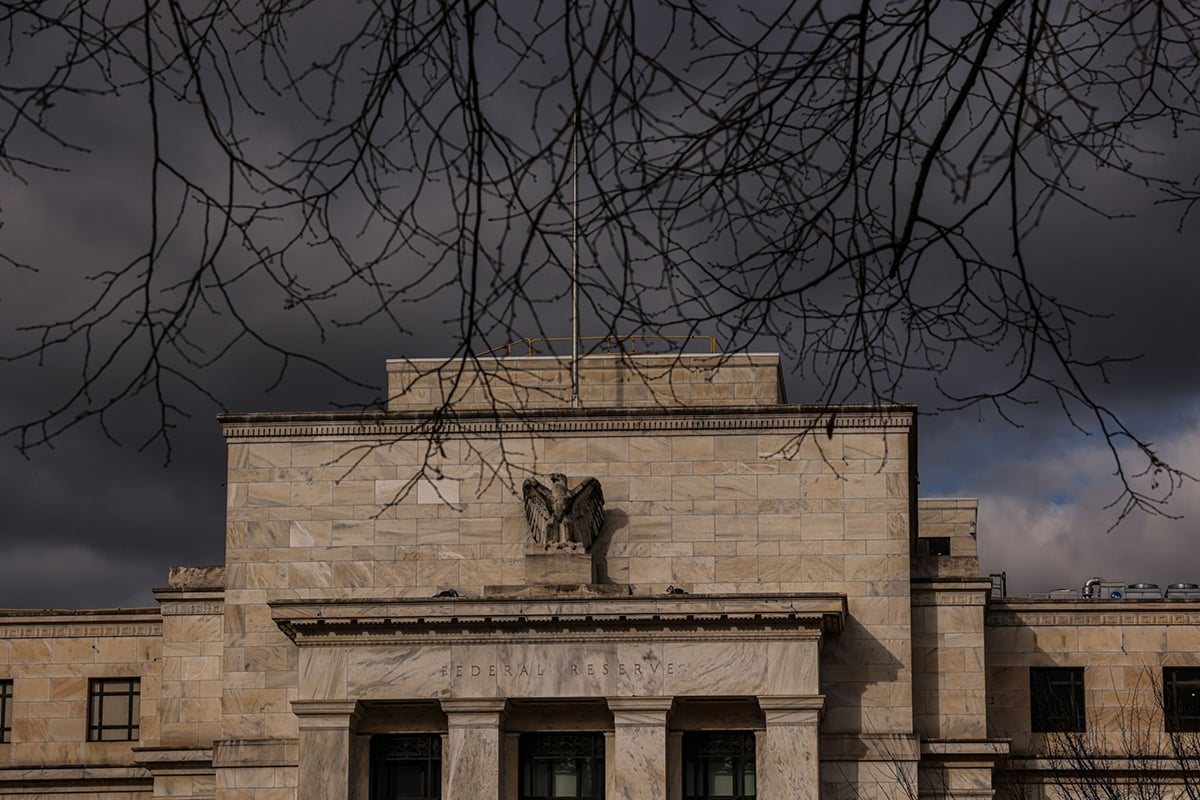The U.S. Congress may have scope to extend debt-limitnegotiations for weeks past the mid-October date when TreasurySecretary Jacob J. Lew has said the nation will exhaust itsborrowing authority, according to analysts at Credit Suisse GroupAG and Jefferies LLC.
|Lew urged lawmakers last week to raise the $16.7 trillionceiling by the middle of next month, and said if they don't theTreasury would be forced to use about $50 billion in cash to fundthe government. Wall Street firms are trying to pinpoint when theTreasury's money runs out: Jefferies predicts sufficient fundsthrough the end of October, while Credit Suisse sees enough cashuntil as late as mid-November.
| A delay past Lew's timetable threatensto disrupt the world's deepest debt market by postponing orreducing Treasury auctions, according to Goldman Sachs Group Inc.Lew's estimate reflects his concern that lawmakers will repeatdelays two years ago that led to the first downgrade of the U.S.'scredit rating, analysts said.
A delay past Lew's timetable threatensto disrupt the world's deepest debt market by postponing orreducing Treasury auctions, according to Goldman Sachs Group Inc.Lew's estimate reflects his concern that lawmakers will repeatdelays two years ago that led to the first downgrade of the U.S.'scredit rating, analysts said.
“It's important for Treasury to have some kind of a deadlinebecause Congress tends to work better when they come up against adeadline,” Ira Jersey, an interest-rate strategist in New York atCredit Suisse, one of the 21 primary dealers of U.S. governmentsecurities that trade with the Federal Reserve, said of Lew's Aug.26 letter to lawmakers.
|The market for U.S. government debt has yet to react to anypotential impasse over raising the borrowing ceiling. Treasuriesthat mature on Oct. 15 yield 0.023 percent, compared with 0.032percent two weeks earlier. Yields on debt due Nov. 7 were littlechanged at 0.015 percent.
|2011 Stalemate
|That wasn't so in August 2011 as Congress pushed deliberationsover raising the debt limit to the deadline set by theTreasury.
|Credit-default swaps tied to U.S. Treasury debt, which provideinsurance against a default and typically rise in cost asinvestors' perceptions of creditworthiness deteriorate, rose to 64basis points in July 2011, the highest since 2009. The contractswere priced at about 22 basis points on Sept. 3, according to dataprovider CMA.
|Investors have become inured to Washington politicians waitinguntil the last minute to reach a compromise, said Thomas Simons, agovernment-debt economist at Jefferies in New York. The primarydealer projects the Treasury will be able to pay its bills untilNov. 1.
|“We've had this understanding that things will get done, butthings will take time,” Simons said. In 2011, Congress learned “howtoxic it was for the markets.”
|The political atmosphere remains contentious. Senator OrrinHatch of Utah, the top Republican on the Senate Finance Committee,is “tremendously disappointed” in the Treasury's deliberations withCongress and its “vague letters,” his spokeswoman, Julia Lawless,said in an interview. Hatch “hopes that will change and thatTreasury officials will be more open and transparent,” shesaid.
|Treasury spokeswoman Brandi Hoffine said in an e-mail thatdepartment officials briefed Hatch's staff this week on the needfor Congress to raise the debt limit “in a timely manner and lookforward to having more conversations.”
|Jefferies' projections on when the U.S. will run out of cash arebased on tax receipts and historical accounting patterns to assessseasonality, Simons said. The bank refers to documents includingthe Daily Treasury Statement, which shows U.S. deposits andwithdrawals of operating cash on everything from federal salariesto deposits from the Postal Service.
|Cash Outlook
|The $50 billion Lew projects will be left in mid-October couldlast until about the end of that month, said Omair Sharif, a U.S.economist at RBS Securities Inc. in Stamford, Connecticut. He saidthe Treasury's cash projections are “pretty spot on.”
|The U.S. will probably run out of cash at the end of October,according to an Aug. 29 Goldman Sachs report, which said failure toraise the debt limit might cause “unnecessary market disruption.”The “absolute drop-dead” date the Treasury runs out of money isNov. 14 or earlier, Credit Suisse's Jersey said.
||Hoffine referred questions about such projections to Lew'sletter to Congress, which said it is “not possible for us toestimate with any precision the date on which Treasury wouldexhaust its cash in this situation. The rate at which cash will bedrawn down depends on facts that are inherently variable andirregular.”
|His predecessor, Timothy F. Geithner, used specific dates thatbecame fodder for critics when the projections changed. FormerAlaska Governor Sarah Palin accused Geithner of giving “differentdue dates” for a catastrophe and said “I don't believe it,”according to a Washington Post report in June 2011.
|Lew “saw what happened when Tim gave a date,” said Steve Bell,senior director of economic policy at the Bipartisan Policy Centerin Washington. It's unlikely the Treasury will be able to pay itsbills any later than early November without an increase, hesaid.
|When Congress does raise the debt limit, “it'll be as gracefulas stumbling over a rock. It won't be New York City Ballet,” saidBell, a Republican and former chief of staff for the Senate BudgetCommittee from 1981 through 1986.
|The U.S. was stripped of its AAA ranking by Standard &Poor's in August 2011, a move that partly reflected the impasseover raising the debt limit as well as the government's lack of aplan to rein in its debt load. The U.S. had demonstrated aweakening “effectiveness, stability, and predictability of Americanpolicy making and political institutions,” S&P said.
|Market Instability
|While the downgrade didn't result in investors charging the U.S.more to borrow, as yields slipped to a record 1.38 percent in July2012, the move contributed to a global stock-market rout thaterased about $6 trillion in value from July 26 to Aug. 12,2011.
|Fitch Ratings, which has a negative outlook on the U.S.'s AAAcredit grade, has said it's considering political wrangling overthe debt limit in its review of the U.S. rating. Moody's InvestorsService in July affirmed its top Aaa grade on the U.S.
|Policy makers, consumed in 2011 with debating ways to reduce theU.S.'s $1.3 trillion budget deficit, now have a stronger fiscalposition. The shortfall was projected to shrink to about $642billion this year and may decline to $378 billion in 2015 beforeincreasing again, according to the Congressional Budget Office.
|The limit on U.S. federal debt originated with the SecondLiberty Bond Act of 1917, which was used to help fund World War I,according to the Congressional Research Service. While the capnever caused a default, “it has at times caused great inconvenienceand has added uncertainty” to the Treasury operations, the servicesaid in a 2010 report.
|Lawmakers have increased the threshold 78 times since 1960,according to the Treasury website.
|“The Congress ought to get serious,” Alice Rivlin, a seniorfellow at the Brookings Institution and former Fed vice chairman,said in a radio interview this week with Tom Keene and Sara Eisenon “Bloomberg Surveillance.” “They need to raise the debt ceilingso we don't have this ridiculous counterproductive argumentagain.”
|Copyright 2018 Bloomberg. All rightsreserved. This material may not be published, broadcast, rewritten,or redistributed.
Complete your profile to continue reading and get FREE access to Treasury & Risk, part of your ALM digital membership.
Your access to unlimited Treasury & Risk content isn’t changing.
Once you are an ALM digital member, you’ll receive:
- Critical Treasury & Risk information including in-depth analysis of treasury and finance best practices, case studies with corporate innovators, informative newsletters, educational webcasts and videos, and resources from industry leaders.
- Exclusive discounts on ALM and Treasury & Risk events.
- Access to other award-winning ALM websites including PropertyCasualty360.com and Law.com.
*May exclude premium content
Already have an account? Sign In
© 2024 ALM Global, LLC, All Rights Reserved. Request academic re-use from www.copyright.com. All other uses, submit a request to [email protected]. For more information visit Asset & Logo Licensing.







